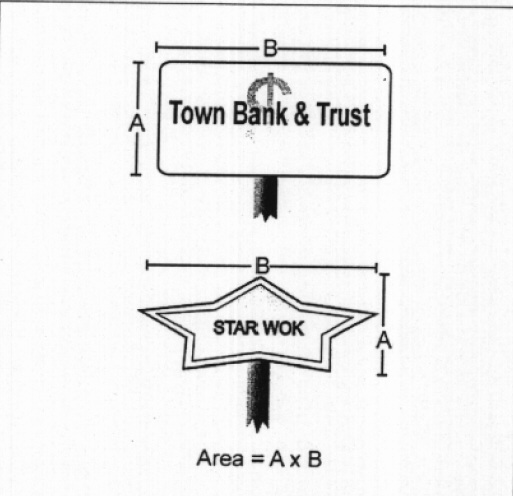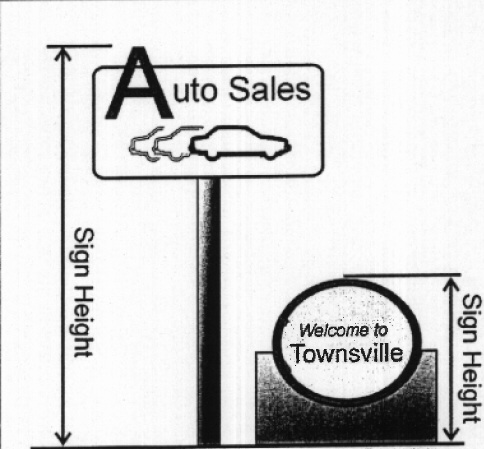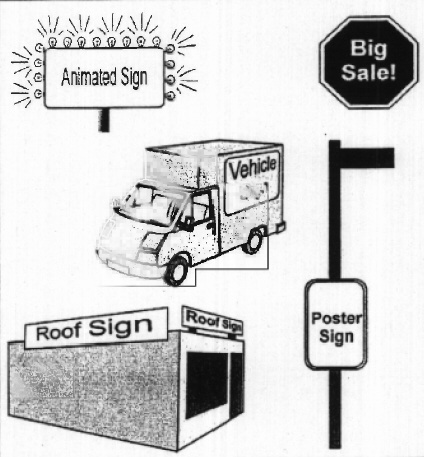(A) Intent. The intent of this subchapter is to further the goals of the Comprehensive Plan; avoid the proliferation of signage; encourage signs to be compatible with the scale of buildings and the surrounding features; maintain and enhance the aesthetic environment of the County; eliminate potential hazards to motorists and pedestrians resulting from signs; and promote the health, safety, and welfare of the residents of Hancock County.
(B) General sign standards applicable to all zoning districts.
(1) General requirements. Except as otherwise provided in this subchapter, it shall be unlawful for any person to erect, construct, enlarge, move or convert any sign within the jurisdiction of the Hancock County Area Plan Commission, or cause the same to be done without first obtaining a sign permit. The following general sign standards apply to all signs within the jurisdiction of the Hancock County Area Plan Commission.
(a) Sign permit review for permanent signs. The following procedure applies to permanent sign/improvement location permit review.
1. Application. Application for a sign permit shall be filed with the Planning Director and shall be accompanied by any information the Planning Director determines is necessary to assure compliance with this chapter, including but not limited to:
a. Clear and legible drawings with descriptions showing the location of the sign which is the subject of the permit.
b. An indication of all existing and anticipated signs on the same property and for the same business use.
c. A dimensioned drawing showing the size of the sign area and the height of the sign.
d. Description of sign materials and colors.
e. Type of illumination.
f. Mounting details.
2. Effect of sign permit issuance. A sign permit issued under the provisions of this section shall not be deemed to constitute permission or authorization to maintain an unlawful sign nor shall it be deemed as a defense in an action to remove an unlawful sign.
3. Expiration. A sign permit shall become null and void if work has not been started within 30 days of the date the permit is issued or completed within 180 days of the date the permit is issued.
(b) Measurement. The sign area shall be calculated by multiplying the maximum vertical dimension by the maximum horizontal dimension including the extreme limits of characters, lettering or figures. The sign height shall be measured from the grade at the edge of the adjacent right-of-way to the highest point of the sign, and include any poles or other supports unless otherwise specified in this subchapter. In no case shall sign height be measured from the top of any berm or other artificial grade.
(c) Double-faced signs. For all signs permitted by this subchapter, a double-sided sign may be erected. Only the sign area of one of the two sides shall be considered the sign area of the entire sign. However, the two sides shall be identical and shall be placed back-to-back, and the maximum distance between the two sides shall not exceed two feet at any point.

Sign Area Measurement Examples

Sign Height Measurement Examples
(d) Inspection. Signs for which a permit is required may be inspected periodically by the Planning Director for compliance with this subchapter.
(e) Removal of sign. The Planning Director may order the removal of any sign erected or maintained in violation of this subchapter, at the cost of the property owner, consistent with the provisions of §§ 156.115 et seq. regarding enforcement and penalties.
(f) Maintenance. All signs and their components shall be kept in good repair and in safe, neat, clean, attractive, and structurally sound condition. Owners shall patch and paint damaged areas when signs are removed within 30 days.
(g) Abandoned sign structures. A sign structure, including all poles, frames, supports, and other structural, electrical, mechanical, and other elements, shall be removed by the owner of the premises upon which it is located if it is unused for a period of six months or greater.
(h) Illuminated signs. All illuminated signs must meet the exterior lighting standards of § 156.077.
(i) Enforcement. The enforcement of violations of the provisions of this subchapter shall be as provided by §§ 156.115 et seq.
(j) Ground/monument sign structure. Sign structure shall be constructed of decorative brick, stone, or other masonry, wood or metal.
(2) Exempt signs. The following signs are exempt from all provisions of this subchapter if in compliance with the conditions specified for each. No permit shall be required.
(a) Integral identification features. Names of buildings, date of erection, monumental citations, commemorative tablets and the like when carved into stone, concrete or similar material or made of bronze, aluminum, or other permanent type construction and made an integral part of the structure.
(b) Public signs. Public signs erected by or on the order of public officer(s) in the performance of public duty, such as signs to promote safety, no trespassing, or traffic signs; memorial plaques; signs of historical interest; and signs directing people to public facilities.
(c) Utility marker signs. Utility signs necessary to mark cables and lines for public and private utilities unless such signs are determined to be a hazard by the Planning Director.
(d) Real estate signs. Real estate signs, provided they are not located in the right-of-way, do not exceed more than two per property, and do not exceed a sign area of six square feet per sign in single-family residential zoning districts and 32 square feet per sign in all other zoning districts. In addition, each subdivision (defined as the area included in each primary and preliminary plat) shall be permitted one temporary sign, not exceeding 32 square feet in sign area).
(e) Sandwich board signs. One sandwich board sign for every business use located on a property. No sandwich board sign may exceed four feet in height, two feet in width, or six square feet in area. Each sign must be located within ten feet of the main entrance of the business for which it is established. The sign shall be located outside of the right-of-way unless otherwise approved by the County Highway or Town Engineer.
(f) Emergency signs. Emergency signs, such as those used by the fire or police department or those displaying employee information.
(g) Sponsorship signs. Sponsorship signs, such as those located inside little league ball diamonds and at other athletic and community facilities, provided such signs are, in the opinion of the Planning Director, oriented to those visiting and using the facility.
(h) Pennants. Pennants, streamers and any combination of such signs, provided that they are not located in a right-of-way and their use is temporary and does not exceed 30 days in any three- month period.
(i) Banners. One banner shall be permitted per business that does not exceed 24 square feet in area and shall be limited to 30 days of use in any three-month period.
(j) Construction signs. Signs posted on construction sites, provided that they are not located in the right-of-way, do not exceed more than two per property, do not exceed six square feet per sign in single-family residential zoning districts and 32 square feet per sign in all other zoning districts, and are removed upon completion of construction activity.
(k) Directional signs. On-premise directional signs provided they are no more than four feet in height or six square feet in area. They shall be setback a minimum of two feet from all public rights-of-way. Directional signage shall not incorporate corporate branding.
(l) Inflatable objects. Inflatable objects, provided that they are not located in a public right-of-way, do not exceed more than one per property or business use (whichever is greater) at any time, no single inflatable object exceeds ten feet in height, and no property or business use (whichever is greater) makes use of any inflatable sign or signs more than seven consecutive days two times per calender year.
(m) Window signs. Window signs that are less than 10% of the window area and with individual letters less than three inches in size.
(n ) Barn signs. Barn signs, provided that they are not located on more than one barn per property.

Exempt Sign Examples
(3) Prohibited signs. The following types of signs are expressly prohibited in all zoning districts.
(a) Animated signs. A sign which in its entirety or in part moves, rotates, flashes, or revolves. Such signs do not include changeable copy signs.
(b) Emissions. Signs that emit audible sound, odor or visible matter.
(c) Imitation of official signs. Signs that purport to be, are in imitation of, or resemble an official traffic sign or signal or which bear the words "Stop", "Slow", "Caution", "Danger", "Warning", or similar words.
(d) Imitation of emergency vehicles. Signs that may be construed as a light of an emergency or road equipment vehicle.
(e) Visual impairment. Signs that hide any traffic or roadway sign, signal or device from view, or that interfere with the sight visibility area as defined in § 156.072.
(f) Encroachment. Signs that are located in any right-of-way including those posted on utility poles or street signs. Projecting signs specified as permitted in this subchapter and approved by the applicable legislative body shall be permitted.
(g) Obstruction. Signs that obstruct any door, fire escape, stairway, or any opening intended to provide entrance or exit for any structure.
(h) Vehicle signs. Signs placed on vehicles or trailers parked on public or private property primarily for the purpose of displaying the sign. Prohibited signs do not include those displayed on vehicles parked for the purpose of lawfully making deliveries or random sales or service. Prohibited signs do not include vehicles which are customarily used for transporting persons or properties, and vehicles parked at a driver's place of residence during non-business hours or for incidental purposes.
(i) Poster signs. Posters, placards and other similar signs attached to light poles, gas station canopy supports, trees, and elsewhere outdoors that are not included as permitted temporary or permanent signs as described by this subchapter.
(j) Permanent roof-mounted signs. Signs that are mounted to the roof of a structure or are mounted to the wall of a structure and extend higher than that wall.

Prohibited Sign Examples
(4) Changeable copy sign standards.
(a) Types. Changeable copy signs consist of two distinct types of signs: manual signs and electronic variable message signs (EVMS). Changeable copy signs shall comply with the requirements of this section in addition to all other provisions of this chapter.
(b) EVMS shall be permitted as a component of one permanent sign for individual uses or business centers per each allowable street frontage, or building frontage.
(c) Amount of a sign that can contain an EVMS. The portion of a sign dedicated for an EVMS shall not exceed 40% of the sign area.
(d) Duration. Changeable copy must have a minimum duration of one minute and must be a static display. No portion of the image may flash, scroll, twirl, change color, or in any manner imitate movement.
(e) Transition. In all districts where a sign changes by EVMS, the change sequence must be accomplished instantaneously and without special effects such as spinning, scrolling or traveling, and must be completed in no less than one second but no more than two seconds.
(f) Brightness and ambient dimmer control. Electronic graphic display signs must have an automatic dimmer control (or photo electric cell) that maintains the minimum amount of light intensity necessary for clear and adequate visibility based on the surrounding ambient light at all times. For residential districts, the illumination must not exceed a maximum brightness of three-tenths (0.3) footcandles above the ambient light. For commercial and industrial districts, the illumination must not exceed a maximum brightness of eight-tenths (0.8) footcandles above the ambient light.
(g) Brightness measurement. Illumination shall be measured from the nearest edge of the nearest street pavement at a height of four to five feet above grade. The brightness of an EVMS sign located perpendicular to the street shall be measured at a 45 degree angle. The brightness of an EVMS sign located parallel to the street shall be measured at a 90 degree angle.
(h) Static display. Fluctuating or flashing illumination shall be prohibited. No portion of any sign may fluctuate in light intensity or use intermittent, strobe or moving light or light that changes in intensity in sudden transitory bursts, streams, zooms, twinkles, sparkles or in any manner that creates the illusion of movement. No portion of any sign may change its message or background in a manner or by a method of display characterized by motion or pictorial imagery, or depict action or a special effect to imitate movement, or the presentation of pictorials or graphics displayed in a progression of frames that give the illusion of motion or the illusion of moving objects, moving patterns or bands of light or expanding or contracting shapes, etc.
(i) Color display. Electronic message boards shall exhibit a consistent background.
(j) Malfunction. In the event of a malfunction, the EVMS shall freeze in one position or shall be shut down.
(k) Off-premise use prohibited. Messages displayed on a changeable copy sign shall not direct attention to a business conducted off the premise.
(l) Public service announcements. EVMS may be used to display public emergency service announcements such as weather alerts, national and local security events, or Amber alerts and the like. In the event of a public emergency only, announcements may scroll continuously, until the message is no longer necessary according to the County Sheriff.
(m) Previously approved, non-conforming. All previously approved existing electronic message signs that contain an electronic changeable copy module which does not comply with the provisions of this section shall be exempt from the brightness and duration of copy provisions of this section.
(n) Portability. Temporary or portable changeable copy signs shall be prohibited in all districts.
(Ord. 2007-1B, passed 2-5-07; Am. Ord. 2011-3E, passed 5-31-11; Am. Ord. 2015-8B, passed 8-4- 15)